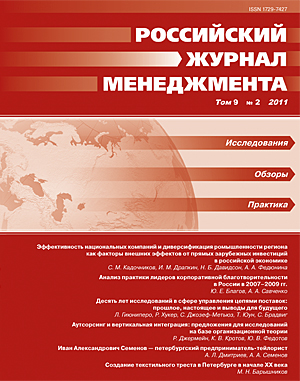Аутсорсинг и вертикальная интеграция: предложения для исследований на базе организационной теории
Аннотация
В данной статье представлен подробный обзор широкого спектра исследований по проблематике аутсорсинга. Анализ аутсорсинга с позиций экономической теории трансакционных издержек дополняется рассмотрением идей ресурсного подхода к фирме, а также организационного подхода. Последний представляет собой новое направление, в рамках которого анализируется влияние факторов на уровне организации на мероприятия в области аутсорсинга и их эффективность. В статье представлен ряд предположений теоретического плана, объединяющих все три рассмотренных подхода.
Ключевые слова:
аутсорсинг, вертикальная интеграция, организационный подход, цепь поставок
Скачивания
Библиографические ссылки
The List of References in Cyrillic Transliterated into Latin Alphabet
Загрузки
Опубликован
Как цитировать
Выпуск
Раздел
Лицензия
Статьи журнала «Российский журнал менеджмента» находятся в открытом доступе и распространяются в соответствии с условиями Лицензионного Договора с Санкт-Петербургским государственным университетом, который бесплатно предоставляет авторам неограниченное распространение и самостоятельное архивирование.





